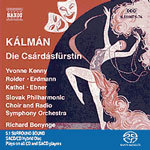
Csardasfurstin (Die) (The Gypsy Princess) (Complete operetta)
 $58.00
Out of Stock
$58.00
Out of Stock6+ weeks add to cart
KALMAN
Csardasfurstin (Die) (The Gypsy Princess) (Complete operetta)
Karl-Michael Ebner (tenor) Mojca Erdmann (soprano) Heinz Holecek (bass) Yvonne Kenny (soprano) / Slovak Radio Symphony Orchestra / Richard Bonynge
[ Naxos Opera Classics SACD / 2 SACD ]
Release Date: Tuesday 1 March 2005
This item is currently out of stock. It may take 6 or more weeks to obtain from when you place your order as this is a specialist product.
Kálmán's great contribution to the musical language of Viennese operetta was to bring to it the brilliant colours, the heady rhythms and the dynamic energy of his native Hungary - not just as an imitator, like so many other composers, but as one who was speaking his own musical mother tongue. - Hybrid/SACD - playable on all CD players
Hybrid/SACD - playable on all CD players
MUSICWEB RECORDINGS OF THE YEAR (2005)
Emmerich Kálmán was born on 24th October 1882 in the Hungarian town of Siofok. His father was a well-todo businessman but was reduced to bankruptcy during Kálmán's childhood, an experience which left a lasting mark on young Kálmán's imagination. The family moved to Budapest, then one of the twin capitals of the Austro-Hungarian Empire, and despite his father's determination that Kálmán should make a career in law it soon became evident that the call of music was too strong to be ignored. Originally Kálmán's ambition was to be a concert pianist, but this was thwarted by an affliction to his arm-muscles. In Kálmán's own words "I was as one who had fallen from the clouds, a very serious and very sad young man". Indeed, according to that great historian of Viennese operetta, Bernard Grun, Kálmán remained that way inclined all his life. "Even at times of his greatest triumphs", wrote Grun, "the stocky man with the friendly blue eyes generally looked very serious and very sad. Rapture and high spirits were as foreign to his nature as bad manners and uncouthness. The Csardas-cavalier was a sober and careful citizen who did his work, kept his finances in order and quietly went on his way."
But to return to Kálmán's youth. He studied composition in Budapest with Professor Koessler, who also taught Bartók and Kodály. In 1907 his serious compositions won him the prestigious Franz-Joseph Prize of the City of Budapest, but within a year he had registered his first outstanding success as an operetta composer. This was Herbstmanöver (Autumn Manoeuvres), which not only brought him to the attention of the operetta moguls in Vienna, but even reached the stages of London and New York. Within a couple of years Kálmán had moved to Vienna, a city which, since the rebirth of operetta with Lehár's irresistible Merry Widow in 1905, had been gripped by a positive epidemic of operetta fever. With Der Zigeunerprimás (1912) Kálmán achieved what he himself always regarded as his finest score, and it moved the authoritative critic Richard Specht to write: "If, after the experiences of the past season, I were to choose one of the operetta-maestri as the man for whose talents I had the highest hopes, that man would be Kálmán." Specht's hopes were not betrayed when, in 1915, Kálmán produced what was to remain his greatest popular success, Die Csárdásfürstin (The Gypsy Princess). Outstanding among his later works were the enchanting Gräfin Maritza (Countess Maritza) (1924) and Die Zirkusprinzessin (The Circus Princess) (1926), and at least four of his other operettas were a great deal more than merely passing successes. In 1938 Kálmán sought refuge from the Nazis in the United States. After the war he returned to Europe and died in Paris on 30th October 1953.
Kálmán's great contribution to the musical language of Viennese operetta was to bring to it the brilliant colours, the heady rhythms and the dynamic energy of his native Hungary - not just as an imitator, like so many other composers, but as one who was speaking his own musical mother tongue. By the time he wrote Die Csárdásfürstin he was achieving an ideal blend of Hungarian soul, Viennese elegance and international sophistication. For the audiences which packed the Johann Strauss Theater for a record-breaking run during the dark days of the First World War it mirrored and preserved a way of life which they were beginning to realise had vanished for ever. They left the theatre feeling better than they had when they went into it, a quality which the piece still pre-eminently possesses.
Apart from a marvellously varied score, one which does not contain a single weak number, Die Csárdásfürstin benefits from an expertly constructed libretto by Leo Stein and Bela Jenbach. The characters are vividly etched, the comic dialogue is still genuinely funny, and the volte face which transforms doom and gloom into a happy ending is a classic of its kind. The mainspring of the plot, a mésalliance between aristocrat and showgirl, may seem today like something which could only exist in the pages of operetta, but that is far from true; in London society, for instance, many an eyebrow was raised when the Marquis of Headfort took as his bride a delectable Gaiety Girl named Rosie Boote The basic ambience of The Gypsy Princess is the world of what in London were called the Stage Door Johnnies, and though it may be tempting today to dismiss them as a bunch of idle wastrels it is worth remembering how many of them, whether from London, Vienna or Budapest, had, by November 1918, sacrificed their lives.

